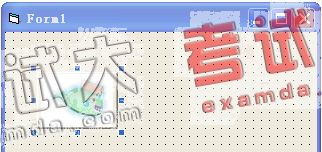 打印本文
打印本文  关闭窗口
关闭窗口 作用:用于开始、中断或结束一个按钮。
(1)常用属性
Caption属性
Style属性
visible =false ' 按钮不可见
enabled=true ' 按钮无效
default =true ' 使按钮成为缺省的“活动按钮”,可用enter键选中
cancel =true ' 使按钮成为缺省的“取消按钮”,可用esc键选中
注意:在一个窗体中,只能有一个命令按钮可以设为缺省的“活动按钮”,也只能有一个命令按钮可以设为缺省的“取消按钮”。
Picture '加载一幅图片
有时.我们可能还需要在命令按钮上显示某个图案以使界面显得活泼生动,要制作这样的按钮,需要设置它的两个属性;styLe属性和Picture属性。我们先将该命令按钮的style属性设置为1(GraPhical),再通过其Picture属性加载一幅图片即可,如图显示了一个带图案的命令按钮。

(2)主要事件
最主要的事件是单击(Click)事件。
(3)常用方法
Print方法:用于在窗体、图片框和打印机上显示文本。其语法格式为:
object.Print [outputlist]
Cls方法:用来清除运行时窗体或图片框所生成的图形和文本。其语法格式为:
object.Cls
Move方法:用于移动窗体或控件,并可以改变其尺寸大小,其语法格式为:
object.Move left, top, width, height
其中:
object:可选项。表示移动窗体或控件。一个对象表达式,其值为“应用于”列表中的一个对象。如果省略object,带有焦点的窗体缺省为 object。
Left:必需项。指示 object 左边的水平坐标 (x-轴)。
Top:可选项。指示 object 顶边的垂直坐标 (y-轴)。
Width:可选项。指示 object 新的宽度。
Height:可选项。指示 object 新的高度。
(4)例子:
见教材P109。计算器应用程序。
代码如下:
Public a, b, result As Double
Public c As Integer
Dim op As String
Dim index As Integer
Private Sub Form_Load()
a = 0
b = 0
Text1.Text =""
End Sub
Private Sub a1_Click()
Text1.Text = Text1.Text & a1.Caption
End Sub
Private Sub a2_Click()
Text1.Text = Text1.Text & a2.Caption
End Sub
Private Sub a3_Click()
Text1.Text = Text1.Text & a3.Caption
End Sub
Private Sub a4_Click()
Text1.Text = Text1.Text & a4.Caption
End Sub
Private Sub a5_Click()
Text1.Text = Text1.Text & a5.Caption
End Sub
Private Sub a6_Click()
Text1.Text = Text1.Text &a6.Caption
End Sub
Private Sub a7_Click()
Text1.Text = Text1.Text & a7.Caption
End Sub
Private Sub a8_Click()
Text1.Text = Text1.Text & a8.Caption
End Sub
Private Sub a9_Click()
Text1.Text = Text1.Text & a9.Caption
End Sub
Private Sub a10_Click()
Text1.Text = Text1.Text & a10.Caption
End Sub
Private Sub a11_Click()
Text1.Text =Text1.Text & a11.Caption
End Sub
Private Sub a12_Click()
b = Text1.Text
index = 0
Select Case op
Case +
result = CDbl(a) + CDbl(b)
Text1.Text = CStr(result)
Case -
result = CDbl(a) - CDbl(b)
Text1.Text = CStr(result)
Case *
result = CDbl(a) * CDbl(b)
Text1.Text = CStr(result)
Case /
If CDbl(b) = 0
Then Text1.Text = error
Else
result = CDbl(a) / CDbl(b)
Text1.Text = CStr(result)
End If
End Select
If Text1.Text = error Then Text1.Text = CStr(result)
End Sub
Private Sub b1_Click()
If index = 0 Then a = Text1.Text
index = index + 1
If index >= 2 Then
b = Text1.Text
Select Case op
Case +
result = CDbl(a) + CDbl(b)
Text1.Text = CStr(result)
a = Text1.Text
b = ""
Text1.Text =""
Case -
result = CDbl(a) - CDbl(b)
Text1.Text = CStr(result)
a = Text1.Text
b = ""
Case *
result = CDbl(a) * CDbl(b)
Text1.Text = CStr(result)
a = Text1.Text
b = ""
Case /
If CDbl(b) = 0
Then Text1.Text = error
Else
result = CDbl(a) / CDbl(b)
Text1.Text = CStr(result)
a = Text1.Text
b =""
End If
End Select
End If
Text1.Text =""
If index >= 2 Then Text1.Text = CStr(result)
op = +
End Sub
Private Sub b2_Click()
If index = 0 Then a = Text1.Text
index = index + 1
If index >= 2 Then
b = Text1.Text
Select Case op
Case +
result = CDbl(a) + CDbl(b)
Text1.Text = CStr(result)
a = Text1.Text
b =""
Text1.Text =""
Case -
result = CDbl(a) - CDbl(b)
Text1.Text = CStr(result)
a = Text1.Text
b = ""
Case *
result = CDbl(a) * CDbl(b)
Text1.Text = CStr(result)
a =Text1.Text
b =""
Case /
If CDbl(b) = 0 Then
Text1.Text = error
Else
result = CDbl(a) / CDbl(b)
Text1.Text = CStr(result)
a = Text1.Text
b = ""
End If
End Select
End If
Text1.Text = ""
If index >= 2 Then Text1.Text = CStr(result)
op = -
End Sub
Private Sub b3_Click()
If index = 0 Then a = Text1.Text
index = index + 1
If index >= 2 Then
b = Text1.Text
Select Case op
Case +
result = CDbl(a) + CDbl(b)
Text1.Text = CStr(result)
a = Text1.Text
b =""
Text1.Text =""
Case -
result = CDbl(a) - CDbl(b)
Text1.Text = CStr(result)
a = Text1.Text
b =""
Case *
result = CDbl(a) * CDbl(b)
Text1.Text = CStr(result)
a = Text1.Text
b =""
Case /
If CDbl(b) = 0 Then
Text1.Text = error
Else
result = CDbl(a) / CDbl(b)
Text1.Text = CStr(result)
a = Text1.Text
b =""
End If
End Select
End If
Text1.Text =""
If index >= 2 Then Text1.Text = CStr(result)
op = *
End Sub
Private Sub b4_Click()
If index = 0 Then a = Text1.Text
index = index + 1
If index >= 2 Then
b = Text1.Text Select
select Case op
Case +
result = CDbl(a) + CDbl(b)
Text1.Text = CStr(result)
a = Text1.Text
b =""
Text1.Text =
Case -
result = CDbl(a) - CDbl(b)
Text1.Text = CStr(result)
a = Text1.Text
b =""
Case *
result = CDbl(a) * CDbl(b)
Text1.Text = CStr(result)
a = Text1.Text
b =""
Case /
If CDbl(b) = 0 Then
Text1.Text = error
Else
result = CDbl(a) / CDbl(b)
Text1.Text = CStr(result)
a = Text1.Text
b = ""
End If
End Select
End If
Text1.Text = ""
If index >= 2 Then Text1.Text = CStr(result)
op = /
End Sub
 打印本文
打印本文  关闭窗口
关闭窗口